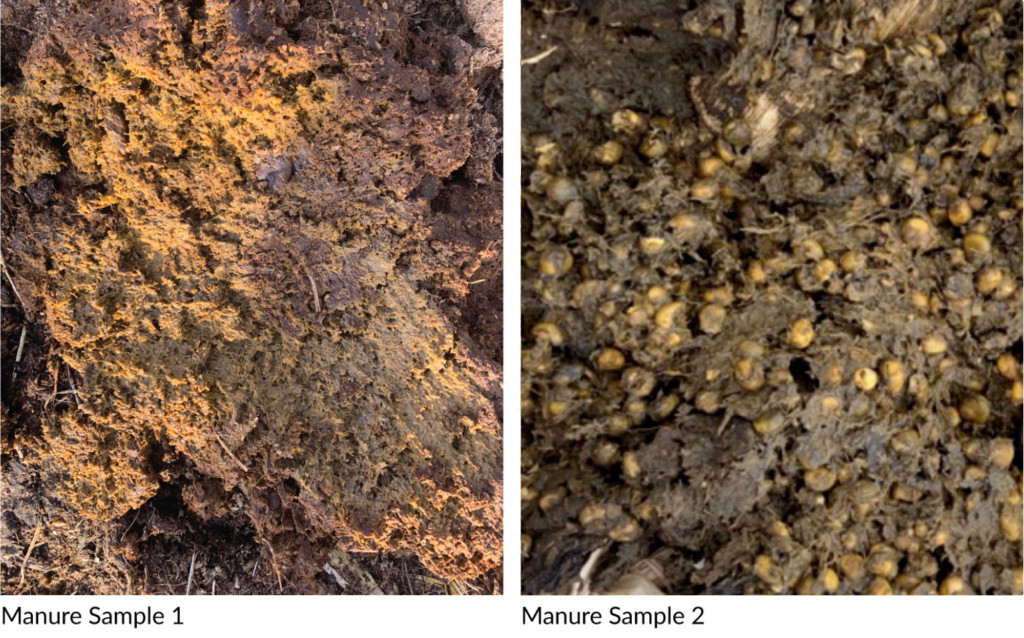The Proof is in the Pudding
We want to share a past article that some of you may have missed. The topic is still very relevant and hopefully useful in understanding how the corn you feed your cattle affects their nutrition.
By Ron Friesen
Do you want to know how well grazing corn is working for your cattle? Check their manure.
If the manure is largely free of yellow corn particles, it means the kernels are soft and highly digestible. If the manure contains a lot of yellow fragments, the kernels are hard and more difficult to digest.

The first manure sample is from a corn hybrid bred specifically for silage. The second is from a grain or dual-purpose corn.
Welcome to the world of floury leafy silage-specific corn hybrids and a new approach to silage and grazing corn.
“The big thing you’re going to notice in the manure is the fecal starch content,” says Jayden Anhorn, Alberta District Sales Manager for NorthStar Genetics. “The floury kernel is going to break down faster. It’s more easily digested in the rumen. So, it’s utilized more efficiently. A dual-purpose hybrid, such as a non-floury, will show little yellow flecks of corn or whole corn kernels in the manure. That’s hard yellow vitreous starch which didn’t get digested.”
The fecal analysis of the manure shown in the pictures further solidifies higher starch digestibility in silage specific hybrids with floury kernels. The analysis showed that 77% of the starch content in the dual-purpose hybrid was found in the manure, whereas only 9% of the silage specific hybrid’s starch was found. Said another way, the cattle digested and utilized 91% of the silage specific’s starch and only 23% of the dual purpose’s starch. “913S (NorthStar Genetics silage specific hybrid in the analysis) is a big, tall plant with an impressive ear and stands very well. It makes for a very good grazer. We’ve seen many 913S cow patties across the Prairies that look like those pictures. I’m not surprised by the analysis, but it is nice for farmers to see the numbers,” Anhorn shares.
The reason floury leafy corn hybrids are more digestible is that they contain a gene which makes kernels floury with no hard starch. This increases starch digestibility and gives floury corn kernels an advantage in feeding cattle, adds Ron Lukash, NorthStar Genetics’ Saskatchewan District Sales Manager.
Because digestion is more efficient, nutrients are absorbed inside the rumen instead of being expelled in the manure. More energy produces milk with a higher fat content in dairy cows, increased average daily gain in beef animals, and more profitability for the producer, says Lukash.
Silage-specific corn currently makes up only a small portion of the corn grown in Western Canada. Over 90% of corn on the market is still bred for grain. But with the initiative in breeding to develop corn hybrids suitable for growing conditions in Western Canada and with their proven performance, silage-specific corn is starting to increase in acreage. That’s especially true for winter grazing, most of which occurs on the Prairies.
“It’s becoming more and more commonplace,” Anhorn says. “NorthStar Genetics is excited to have silage specific hybrids available for Western Canadian farmers.”
In addition to the enhanced starch digestibility of the kernel, farmers are impressed with how well silage specific hybrids stand for grazing, the high tonnage and superb clean-up. “There is very little waste. The cattle do an excellent job of cleaning up the corn,” adds Anhorn.

“It boils down to how you get paid,” he says. “If you’re a dairy operation, you get paid for pounds of butterfat. If you’re a beef farmer, you get paid for pounds of beef gain. At the end of the day, this corn is bred for your herd.”
Because grain corn and silage specific corn are bred for different purposes, they have opposite characteristics.
Grain corn has hard durable kernels that stand up during combining, shipping, and storage. It’s a late-season crop, so the stalk is stiff and solid for standability. The ear is located high up in the plant, making it readily accessible to the combine.
Silage corn is not combined and is used strictly for silage or grazing. As a result, its stalk is digestible, and the ear is positioned low in the plant with large palatable leaves growing above it. Anhorn says leafy corn averages six to seven more leaves above the ear than a non-leafy hybrid.
Anhorn expects more acres will convert to silage specific hybrids with the floury kernel as more producers become aware and experience the benefits to livestock.
“This is going to take over corn grazing acres and you’ll see more farmers grazing silage specific corn,” Anhorn says. “When they see how good of a grazer it is, they’re going to convert their dual-purpose hybrid acres to floury leafy hybrids.
“I see it gaining a lot of traction. I see it being used for silage, I see it being used for grazing and absolutely more and more acres every year. The truth will be in the performance of the corn hybrids, the performance of the animals, and the amount of corn found in the manure. After all, corn doesn’t lie.”



